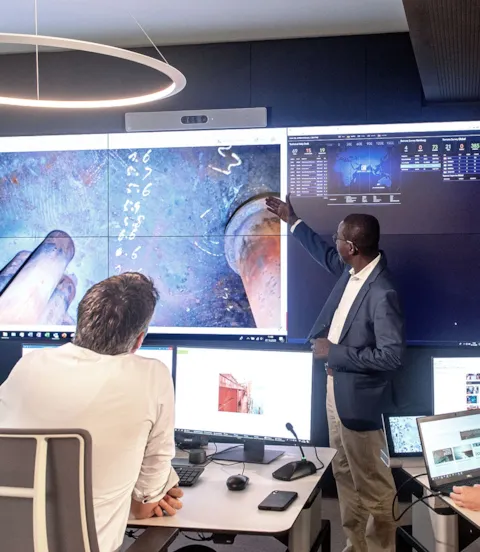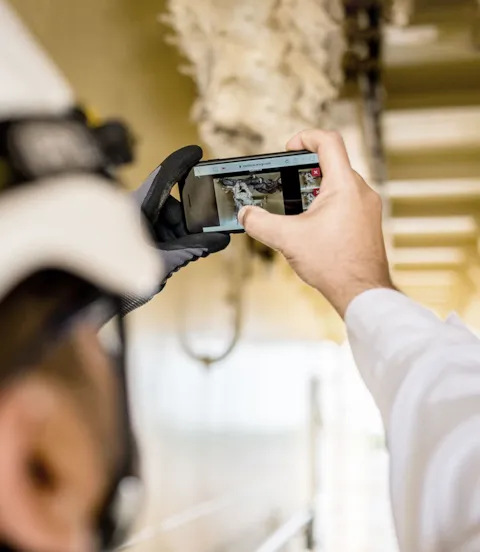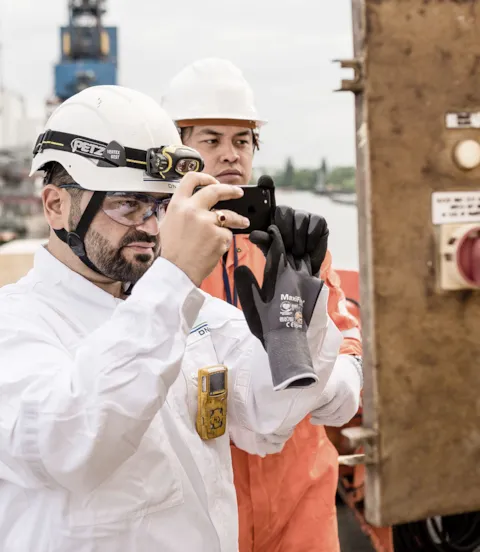Seafarers zoom in on remote surveys of ships
With rising use of remote surveys, feedback from shipowners is helping DNV to optimize this approach to assessing compliance with class and statutory regulation, and to make it easier and safer for crew members acting as our eyes and ears on ships.
Remote surveys directed by DNV experts ashore, with crews handling cameras on vessels, have become more common as Covid-19 lockdowns have prevented surveyors travelling to some locations. Covid aside, a remote survey avoids waiting time for a surveyor to reach the vessel, as well as unnecessary travel costs. Surveys can be performed by remote surveyors 24/7, anywhere in the world, even for a vessel in a remote location. Remote surveys are quicker, produces survey documentation instantly, and even cuts down on carbon dioxide emissions.

Crews play key roles in remote surveys
Seafarers play key roles in enabling remote surveys to deliver superior safety and business benefits to their shipmates and owners. They will be called on increasingly to complement these roles, suggests Kamlesd Kumar, Head of Class Systematics & Operational Centre, DNV: “Remote surveys were catching on for ships even before 2020; and for some types of survey, the approach could become ‘the new normal’ after the pandemic.”
For crews assisting with DNV remote surveys, real-time instructions come over an online connection or video streaming link from our remote surveyors strategically located in one of our Direct Access to Technical Experts (DATE) units. We have about 60 trained remote surveyors across these units in Høvik (Norway), Hamburg (Germany), Singapore, Houston (US), and Piraeus (Greece).

What happens in a remote survey?
DNV’s remote surveyors and the customer first identify, collect, and review all necessary documents. “We may have online conversations with the shipmaster and chief engineer and take written statements from them. We need access to relevant documentation, typically repair reports, spare parts delivery notices/orders and so on,” Kumar explains.
DNV and the customer also plan what should happen during the survey, and who will do it. As part of this process, they work out how to avoid any safety risks to camera operators (or their crewmates) whose attention will be on handling the camera typically built into a smartphone, tablet or safety helmet.

Mobile cameras are key equipment on board surveyed vessels
Crew members could then find themselves walking around with cameras to send DNV still pictures and livestreamed or recorded videos. “For example, we may ask the camera handler to zoom in on a replacement valve’s nameplate showing the manufacturer and serial number,” Kumar observes. “This work will be slow as our remote surveyors give directions so they can witness everything they need to see. They provide clear instructions, enabling the crew to get it right first time, and safely.” Crew members working on different vessels may find slight variations in how surveys are conducted. For example, on a tanker, an explosion-proof camera needs to be used to eliminate the risks associated with electronic devices on deck.

Crew feedback helps to improve processes
As the practice grows, customer feedback is helping DNV to enhance remote surveys and make the process easier and safer for crews acting as our eyes and ears on ships. “Feedback is generally positive, but the deeper value comes in discovering what customers think could be done to improve the experience in future,” Kumar admits.
Captain Stian Bøe from Buksèr og Berging AS, Norway, shared his experience from the pilot trial of an annual remote survey for the tug BOKN: “We think the survey of our vessel went very well, and better than we expected, thanks to very good guidance and help along the way from all the representatives from DNV.”

Learnings from the pilot trial of an annual remote survey
For the tug BOKN, representatives from DNV, the vessel’s master and chief engineer, and Buksèr og Berging’s fleet manager, first held a planning meeting using Microsoft Teams. They discussed what documentation was needed in advance, how the survey would be carried out, and the detailed survey plan. Following preparations, the annual remote survey took place three days later with a kick-off meeting between the same participants using Microsoft Teams on the computer on BOKN’s bridge. They went through all the pre-submitted documentation and made a plan for the day. Using two headset-equipped mobile phones, each connected to its own Microsoft Teams account, the actual survey then began via a live stream. The lead surveyor of DNV’s DATE unit in Høvik guided the customer’s representatives through the plan step by step, explaining what he wanted to see along the way. The team on board completed all points in the survey plan and the general condition of the vessel was shown.

Using more than one mobile phone is instrumental
Captain Stian Bøe reports a number of learnings: “Using two mobile phones with separate accounts proved very useful. It meant we could document that things worked as they should by filming an activation and the result of an activation at the same time.”
For example, the chief engineer filmed the activation of a smoke detector, and that the fire door closed at the same time, while the master filmed the activations showing on the fire control panel on the bridge. When they tested quick-closing valves, the chief engineer filmed the activation of each valve from the deck while the master simultaneously filmed the valve closing itself correctly in the engine room.

Surveyor visits remain essential
Typical reasons for remote survey requests include, among others, for condition handling, occasional surveys, minor damage surveys, postponement of surveys, and completion of periodical surveys with minor outstanding items. One example of an ‘occasional survey’ being required is when there is a change of load line on a vessel that already has multiple load lines assigned. This can normally be done remotely depending on individual flag authorization. Once a remote survey request has been made through DNV’s Veracity portal, a surveyor will be assigned. Various steps and evidence will then need to be followed/submitted as a bare minimum.
Not all surveys can be remotely handled. DNV has also performed pilots for remote periodical surveys but experience showed that on-board surveys are the preferable survey method here. “However, requests are evaluated case-by-case, and we check that a remote survey is appropriate,” Kumar says. “For example, while it is normally possible to conduct remote surveys when an anchor is lost, it is not normally possible where the vessel has been in a major collision .”

Kamlesd Kumar
Head of Section, Operational Centre and Class Systematics
- DNV
- DNV/Jörg Autermann